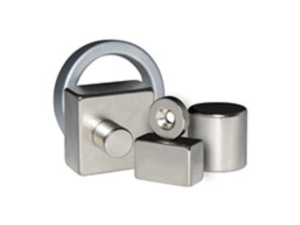


Your magnets may need occasional testing to verify that they still perform as expected. Several environmental and adverse use factors can damage the strength of a magnet. Learn about magnet strength, including how to test it.
To test the strength of a magnet, you need to determine whether you want to test the force or the magnetic field. Magnetic measurement units depend on the test performed. A test of the force indicates the amount of force a magnet can hold before breaking, measured in kilograms. A magnetic field test shows the strength of the magnetic pull in the field around the magnet, measured in gauss units.
A pull test kit will help you measure the magnetic force of a magnet.
A gaussmeter measures the magnetic field. This type of test includes a probe that finds the magnetic field strength at different points based on the shape of the magnet.
Magnets have grades that indicate their manufactured strength in mega gauss units or Tesla units. For example, an N42 magnet measures 42 mega gauss or 4,200 Tesla units. The grade of a magnet relates to its maximum energy product in megagauss-oersteds (MGOes). This measurement is the highest point on the curve indicating the strength of the magnet in how difficult it is to demagnetize it.
The material type will determine the MGOes measurements. Neodymium magnets have MGOes values between 35 and 52, making them the strongest type of magnet. Other magnet materials and their MGOes values include:
The best magnet materials and MGOes values for your needs depend on how you will use the magnets.
A gauss unit measures the magnetic induction (B), which indicates magnetic field strength in magnetic flux lines per square centimeter. It has several other equivalents in different measuring systems, such as the English measurement lines of magnetic flux per square inch and the S.I. unit of Tesla, which measures webers per square meter.
Since a gauss unit measures per square centimeter, it is a much smaller unit than a Tesla. One gauss equals 1/10,000 of a Tesla.
There are different ways to test the strength of a magnet — a pull test and gaussmeter measurement. Both indicate the force of the magnet in different ways.
A pull test is another means of testing magnet strength. Instead of measuring the magnetic field as a gaussmeter does, a pull test looks at the magnetic power by determining how much force the magnet can hold.
This type of test uses a specific test piece that should match the type of magnet you test. Consult the test kit instructions to choose the correct test piece size and shape. A pull test involves the following steps:
A gaussmeter is an essential tool for measuring the strength of the magnetic field around a magnet. These devices come with one of two types of probes — transverse or axial. The type of probe will determine how you orient it in relation to the magnet.
Transverse probes use their thickness to measure the magnetic field and should be perpendicular to the magnet. Avoid touching the magnet directly with a transverse probe since it can give falsely higher results if the “hot” side of the probe touches the magnet. Axial probes should be parallel to the magnets because they measure the field strength through their axis.
The distance from the magnet plays a role in the magnetic field measurement. To ensure consistency when testing with a gaussmeter, use a fixture that supports the probe at a set distance from the magnet. Use the manufacturers’ recommendations for this distance, which comes from the shape of the magnet. Comparing your measured values to those from the manufacturer will help you identify any changes that may have occurred from when the magnets were new.
Gauss on cylindrical or block-shaped magnets is measured directly on the surface at the center axis of magnetization. Ring-shaped magnets have two values for the magnetic field, measured in the air in the center of the hole through the magnet. The second value comes from the surface of the ring halfway between the inner ring and the outside.
Get reliable industrial-grade magnets from an industry leader at Rochester Magnet. Our options include rare earth magnets, flexible magnets, printable magnets, pressure-sensitive adhesives, magnetic assemblies and more. Contact us at Rochester Magnet today to request a quote for our industrial magnets or other related products.

Magnetic sheeting is a flexible material that can be magnetized on one side and often has an adhesive or printable surface on the other. It

Magnets come in various shapes and sizes, each designed for specific uses. Understanding the different shapes of magnets, their properties, and their applications can help

Magnets are a fascinating part of our everyday lives, from the magnets on our fridge doors to the powerful magnets used in advanced technology. There
Our magnet experts will help you get exactly what you need – custom or stock – in record time with great quality at a very competitive price.
Ⓒ 2024 - All Rights Are Reserved